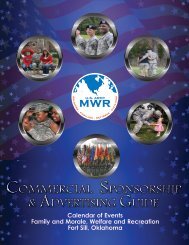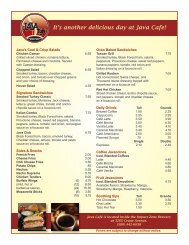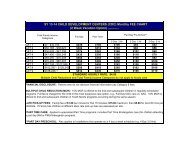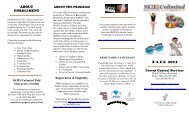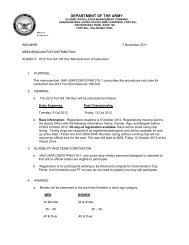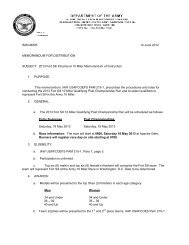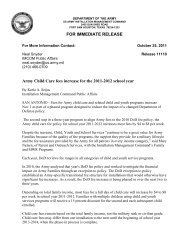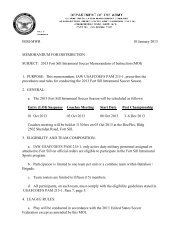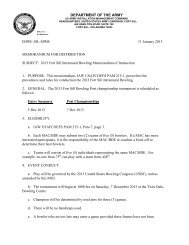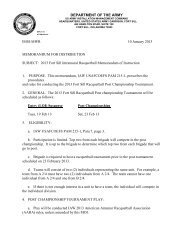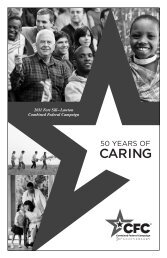Preparing and Managing Correspondence - Fort Sill MWR
Preparing and Managing Correspondence - Fort Sill MWR
Preparing and Managing Correspondence - Fort Sill MWR
You also want an ePaper? Increase the reach of your titles
YUMPU automatically turns print PDFs into web optimized ePapers that Google loves.
F–10. Extracts<br />
Extracts from a document are identified by the original chapter, article, <strong>and</strong> paragraph numbers, as appropriate but<br />
never by page numbers. When a document is translated or reprinted, the original chapter, article, <strong>and</strong> paragraph<br />
numbers are retained, but the page numbers may be changed.<br />
F–11. Specific points<br />
Specific points in tables or diagrams may need to be amplified by notes. These are normally placed at the foot of the<br />
document (or other convenient place) under the heading Notes. They are numbered consecutively in Arabic numerals,<br />
the series starting anew for each supplementary document. Attention is drawn to the relevant note by inserting the<br />
appropriate numeral in brackets immediately after the point.<br />
F–12. Footnotes<br />
Footnotes may also be used in the body of military correspondence <strong>and</strong> are useful for crossreferences or explanations<br />
that do not affect the substance of the paper. Lengthy footnotes should be avoided.<br />
F–13. Abbreviations<br />
a. Abbreviations are not normally used in military correspondence covered by STANAG 2066 if it is to be<br />
circulated between Allied Forces.<br />
b. If abbreviations are used, the word or words abbreviated are to be written in full on first appearance, followed by<br />
the appropriate abbreviation in parentheses. Abbreviations st<strong>and</strong>ing for combinations of words are written in uppercase<br />
letters without spaces or punctuation, for example, Supreme Headquarters Allied Powers Europe (SHAPE).<br />
c. Related documents dealing with abbreviations are as follows:<br />
(1) NATO H<strong>and</strong>book C(1), part III, contains the authorized short titles for NATO military comm<strong>and</strong>s <strong>and</strong> agencies.<br />
(2) AAP–15 is a glossary of abbreviations in common use in NATO but does not constitute an authority for their<br />
use. The procedure in paragraph b above must be followed when such abbreviations are used.<br />
(3) Agreed national distinguishing letters for use by NATO Forces are contained in STANAG 1059.<br />
d. The use of military abbreviations is not precluded in particular cases <strong>and</strong> may be authorized from time to time.<br />
e. See also AR 310–50.<br />
AR 25–50 • 3 June 2002<br />
101




